Craving a Tokyo experience that goes beyond the usual tourist hotspots? Look no further than Katsushika Ward! This hidden gem is one of Tokyo’s 23 wards, brimming with diverse neighborhoods, each with its own unique personality. Wondering what to do, where to stay, or even what Katsushika is all about? This ultimate guide to Katsushika Ward has you covered. We’ll unveil the best things to see, the rich history, and hidden corners waiting to be explored. So, ditch the typical Tokyo itinerary and get ready for an unforgettable adventure in Katsushika Ward!
A Quick Primer to Katsushika Ward

Katsushika-ku, located in the northeastern part of Tokyo’s 23 wards, is one of the three downtown wards of Tokyo, along with Adachi and Edogawa. The image of Katsushika-ku has been shaped by two well-known characters, Torajiro Kuruma of “Otoko wa Tsuraiyo” and Kankichi Ryotsu of “Kochira Katsushika-ku Kameari Koen Mae Hashutsujo”.
Katsushika-ku is a quintessential downtown area, with much of it being an extension of the downtown region that expanded into the suburbs across the Arakawa River from the cramped Taito and Sumida wards during the early Showa period to the postwar period. The area was once the centre of the celluloid manufacturing industry, and there was a time when the majority of celluloid products, such as toys, were made solely in Katsushika-ku.
Today, the area remains a residential space for common people, with a series of town factories and row houses along the Keisei Line, preserving the DNA of the area across generations. Tateishi, a sacred place for downtown drinking where daytime sake is the norm, has become a bit of a tourist attraction, drawing drinkers from far and wide. Shibamata, famous for Tora-san, and Kameari, famous for Ryosan, have even attracted international tourists on “pilgrimages to sacred places”.
However, like Adachi and Edogawa, the area lacks a transportation network that connects directly to the city centre, resulting in a lower percentage of people moving to Tokyo from the countryside and fewer commuting businessmen. Since Narita Airport is only one line away from the Keisei Line, many foreigners reside in this area.
Living in Katsushika Ward City Ward

Katsushika Ward is the strongest downtown area in the 23 wards, where chirpy Edokko live today. Consequently, the residents are keen to preserve old traditions and resist change. In front of Kyonarishi Station, the Communist Party gives speeches to low-income residents, but in the end, the LDP wins due to the organised vote of construction workers.
The shopping district around Keisei Tateishi Station, which symbolises Katsushika’s old-fashioned spirit, is now in danger of losing its precious “downtown Tokyo station scenery of the Showa period” as it pushes through a redevelopment plan for the elevated railway construction at the last minute.
The rate of students going on to university is the second lowest after Adachi Ward, with figures showing little difference. Unless a family wishes to raise their child to be a craftsman working at a local factory, it is believed that there is no reason to choose this area for raising children.
History of Katsushika City Ward
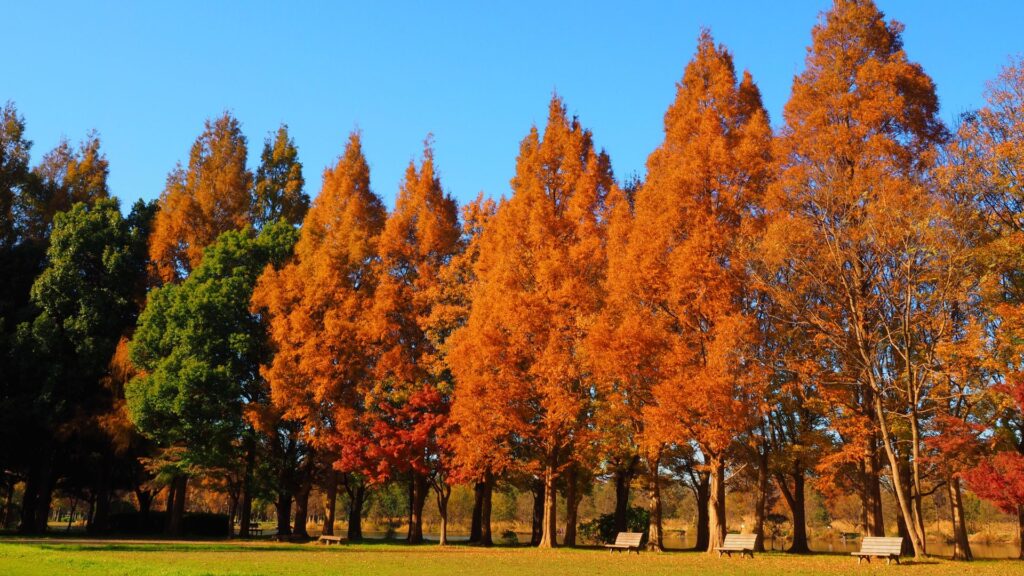
In ancient times, Katsushika included a vast area extending into what are now Chiba, Saitama, and Ibaraki prefectures. In the Kamakura period, the Kasai clan ruled the area, and in the Edo period, the area around Katsushika Ward was designated as a natural territory, remaining an undeveloped area where the shogun’s hawk hunting grounds were located.
In 1869, the area was incorporated into Kosuge Prefecture, and in 1878 into Minami-Katsushika-gun, Tokyo Prefecture. In 1932, Katsushika Ward was created through the merger of seven towns and villages: Shinjuku, Kanamachi, Mizumoto, Kameari, Honda, Minami Ayase, and Okudo.
Katsushika City was less affected by the Great Kanto Earthquake, leading to a rapid increase in residents migrating from central Tokyo. Even during the Pacific War, Katsushika Ward suffered less damage than other wards, resulting in another population influx.
During the Korean War, small-scale industries developed remarkably, and the number of munitions factories increased dramatically. However, as the country entered a period of rapid economic growth, mechanisation and rationalisation progressed, leading to a gradual decline in the number of factories. At that time, problems such as overcrowded residential areas and pollution occurred. In recent years, however, the population has been decreasing, and parks and new landscaping have been actively developed.
Katsushika Ward Areas
Along the Keisei Main Line, Oshiage Line, Kanamachi Line, Hokuso Line
Horikirishobuen 堀切菖蒲園
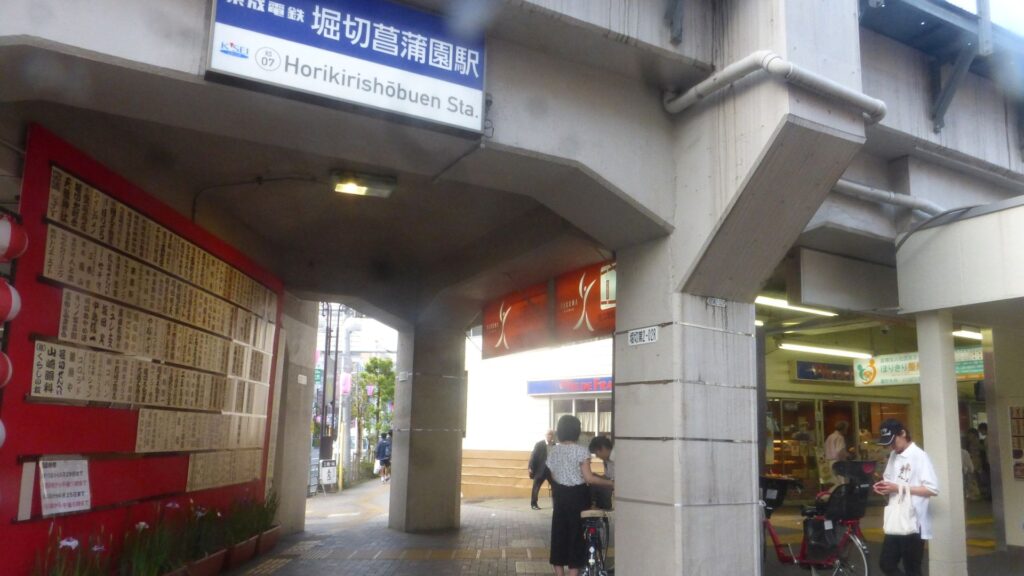
A riverside town in Katsushika reached by the Keisei Main Line. As the station’s name suggests, Horikirishobuen is its speciality. The Tobu Isezaki Line’s Horikiri Station on the other side of the river, cut off by the Arakawa River drain, used to be connected to the station.
Ohanajaya お花茶屋
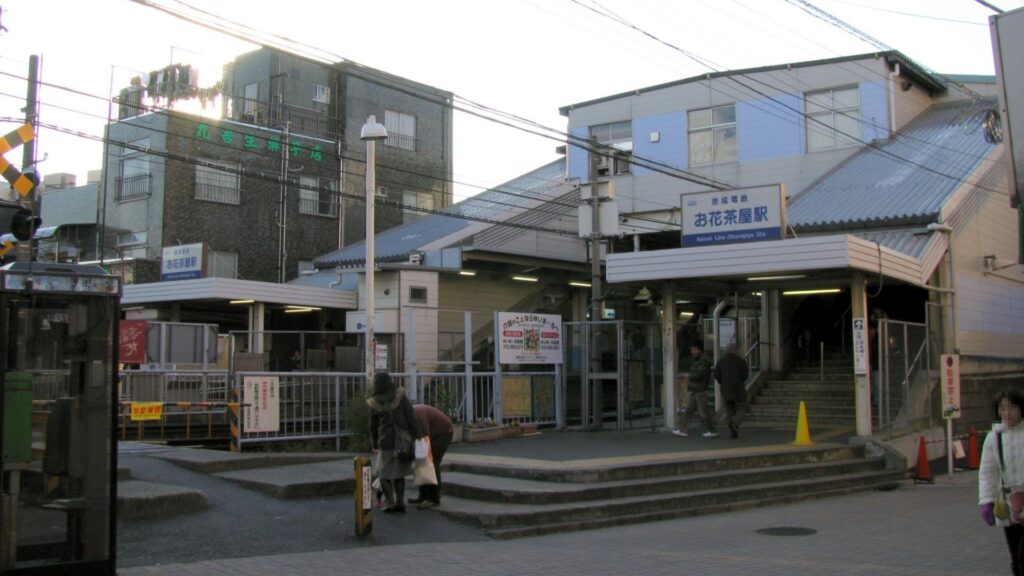
There are no flower gardens or teahouses in front of the station, but there is a Yotsugi funeral hall. The three Kameda boxing brothers, who were born in Nishinari, Osaka, decided they had no choice but to win and moved to Tokyo. There are many tokutei residential houses, and the atmosphere is somewhat Osaka-like.
Aoto 青砥

Aoto Station is where the Keisei Main Line and the Keisei Oshiage Line intersect. The station has a two-tiered platform structure and is fortress-like, similar to Keikyu Kamata. However, the shopping area in front of the station is slightly more prosperous.
Keisei Takasago 京成高砂

This is a transfer station for Keisei Line users, along with the neighbouring Aoto Station. From here, visitors can take the Keisei Kanamachi Line to Shibamata, where Kuruma Torajiro lives. The Hokuso Line, said to be the most expensive private railway in Japan, branches off from this station. It costs 570 yen to Shin-Kamagaya and 760 yen to Chiba NT Chuo.
Yotsugi 四ツ木
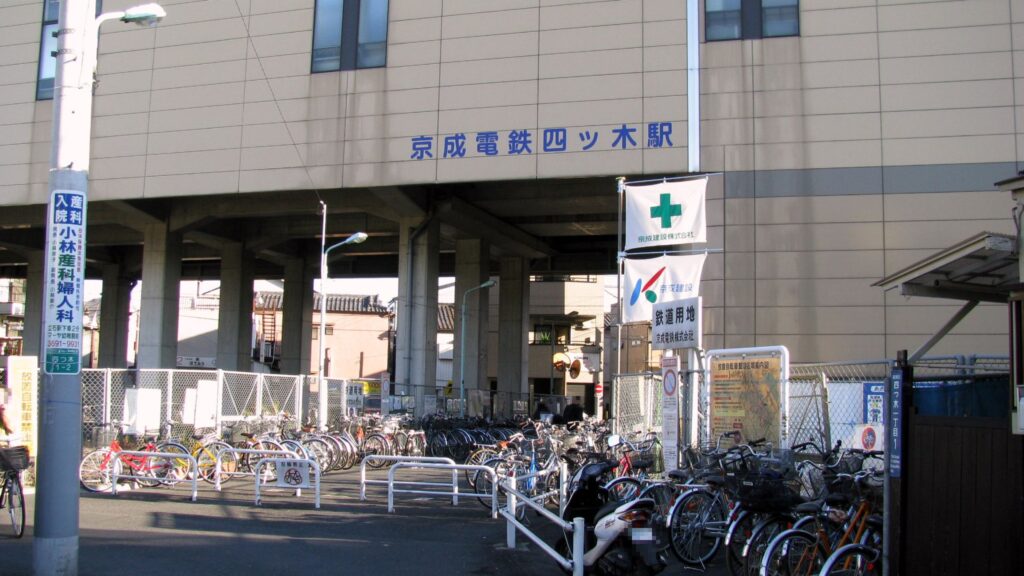
In a sense, a dense area of factories and wooden houses symbolises Katsushika Ward. The percentage of houses with blue tin roofs is the highest in Tokyo. Abandoned houses also stand out. The wreckage of the market near Kinegawa Elementary School and the remnants of the Showa period showcase what is left of the Showa era.
Keisei Tateishi 京成立石

The nearest station to Katsushika Ward Office, the shopping street in front of the station is a paradise for daytime drinking. The postwar atmosphere of the drinking alley may disappear with the wave of redevelopment. Tateishi-sama and Katsuei-sama are the objects of worship of the local people.
Shibamata 柴又

This is the hometown of Torajiro Kuruma of “Otoko wa Tsuraiyo”. The Teishakuten approach stretching from the front of the station is the most popular tourist street in Shibamata. However, the shopping street in front of the station should not be missed. Teishakuten’s water comes from the giant Kanamachi water purification plant. There is also the Yagiri no Watashi (crossing of the Yagiri River), which is well-known for its enka (Japanese folk song).
Shin-Shibamata 新柴又

A station on the ridiculously expensive Hokuso Line. It is doubtful whether there are any users, but there is “Kamakura, Katsushika-ku,” which is not a high-class residential area. The local speciality, a coin-operated laundromat with portraits, is also very impressive.
Along the JR Joban Loop Line and Sobu Line
Ayase 綾瀬
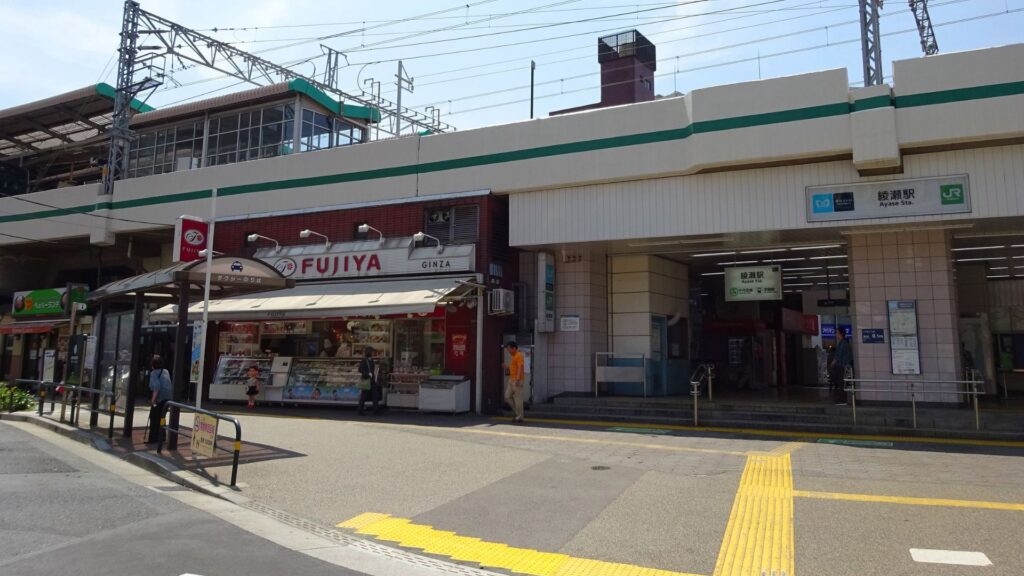
The area in front of the station is in Adachi Ward, but Kosuge 4-chome, Katsushika Ward, protrudes from the south entrance along the old river line. The Tokyo Detention Center, one of the largest in Japan, stands in Kosuge 1-chome on the west side of the Ayase River.
Kameari 亀有
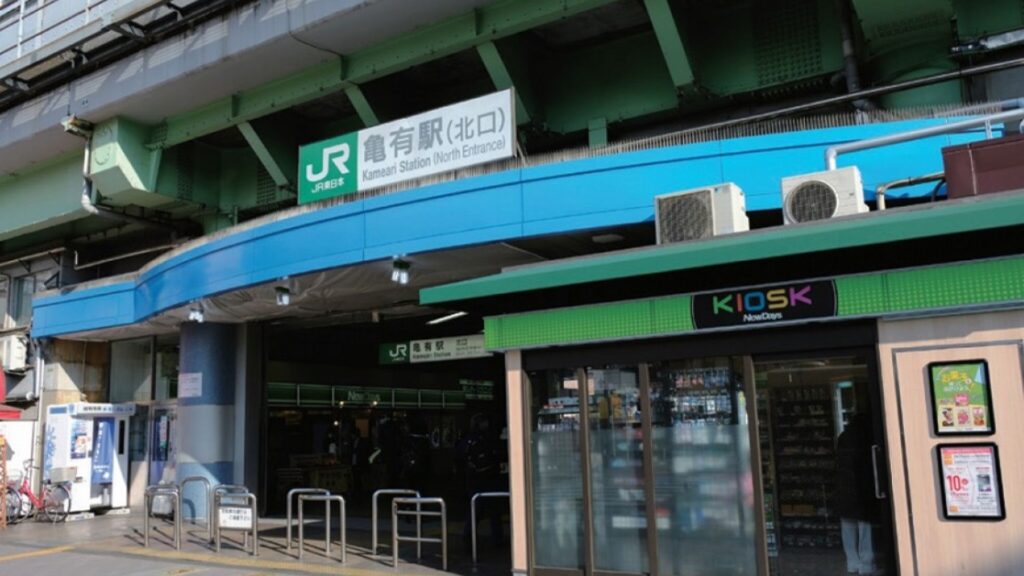
This is a well-known “Kochikame” holy land. A golden statue of Kankichi Ryotsu stands in front of the station. Kakurebi along the railroad line and the densely populated area of suspicious salons at the north exit. The retro Kameari food market at the south exit to the latest trend-setting Ario Kameari are all here.
Kanamachi 金町
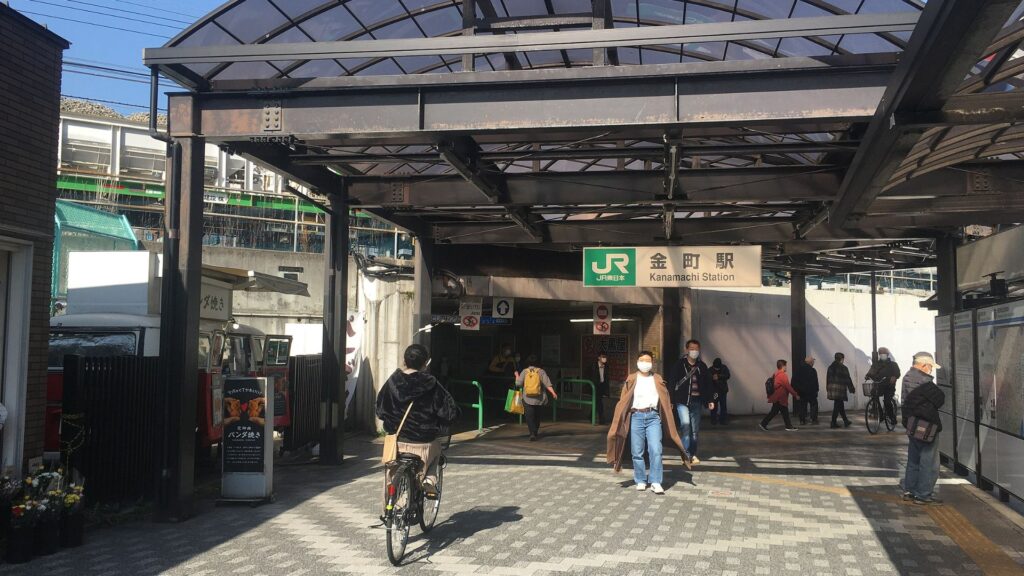
The farthest end of the Tokyo metropolitan area reached by the Joban Loop Line. Huge apartment complexes are located in prime areas in front of the station. It is Katsushika’s version of Little Manila along with Takenotsuka in Adachi-ku. The Kanamachi Udon group is a tough competitor in the food and beverage department.
Shinkoiwa 新小岩

The station platform has become a new suicide spot. The Lumiere shopping street at the south exit is the key. There are too many pachinko parlours, cheap bars, and snack bars, and the Sobu Line culture of drinking, hitting, and buying is here.
Other Areas
Mizumoto 水元

The farthest end of Katsushika City, reached by bus from Kanamachi. Mizumoto Park and Nanzoin Shibare Jizo are famous for their vast Kogatame and irises, which is hard to believe are in Tokyo. Across the pond is Misato City, Saitama Prefecture.
Best Things to Do in Katsushika Ward
Mizumoto Park 水元公園
Located in Katsushika Ward, Mizumoto Park is one of the largest suigo parks in Tokyo and is famous as one of the few places where the onibasu, a natural treasure of the Tokyo Metropolitan Government, grows naturally. In addition to rows of cherry and poplar trees, visitors can see a variety of aquatic plants such as Hanashobu, water lilies, and Japanese morning glory in the lush green park.
The park also has a barbecue plaza that can be reserved in advance, and a campsite that can be used for educational purposes for young people.
Find out more about Mizumoto Park here on Google maps.
Horikiri Iris Garden 堀切菖蒲園

Horikiri iris garden is a botanical garden located in Horikiri, Katsushika-ku. In addition to irises, which are at their best from early to mid-June, visitors can enjoy viewing plum blossoms, peonies, winter cherry blossoms, wisteria, and other seasonal flowers. The garden also features the “Seikan-tei” restaurant, which serves seasonal Japanese cuisine and has a coffee shop for casual visits.
Find out more about Horikiri iris garden here on Google maps.
Yagiri no Watashi 矢切の渡し(松戸側)
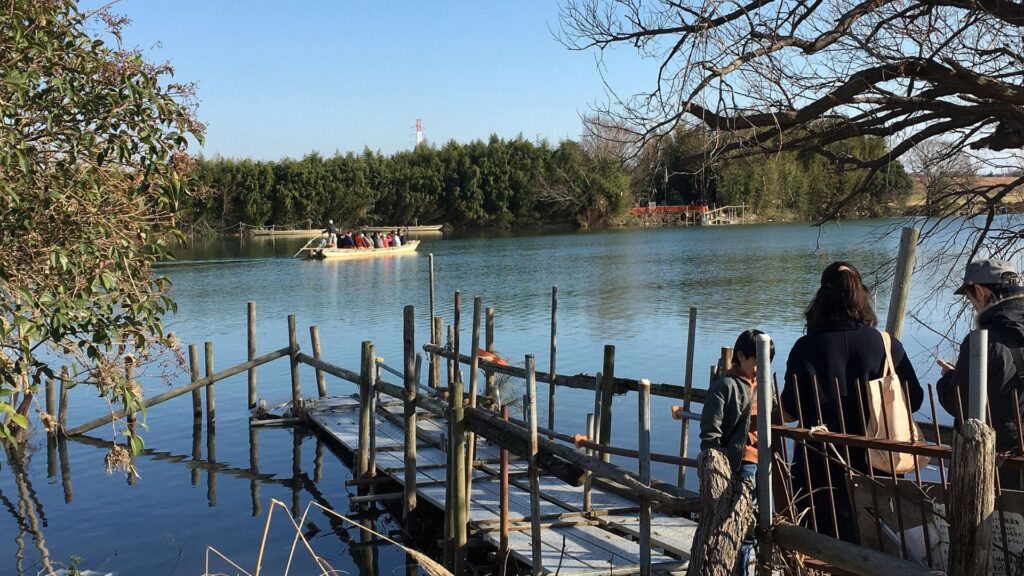
This ferry, which has been in operation since the early Edo period, connects Shibamata with Chiba Prefecture on the other side of the river. It is the only surviving farmers’ ferry on the Edo River, connecting Yagiri to Shibamata in Katsushika Ward, and is the only valuable ferry that remains in Tokyo. It was established in the early Edo period as a ferry on the Tone River system. The ferry operates daily in summer and only on weekends and holidays in winter.
Find out more about Yagiri no Watashi here on Google maps.
Tora-san Museum 葛飾柴又寅さん記念館
The Tora-san Memorial Museum recreates and exhibits the world of the movie “Otoko wa Tsuraiyo” and other materials. A set from Kurumaya, Tora-san’s favourite dumpling shop in Shibamata, has been relocated to the museum, and the contents of the trunk that Tora-san, who loved to travel, always carried in his hand are also on display.
There is also a quiz corner about the film and a corner where visitors can view famous scenes. From Shibamata Park on the rooftop, visitors can view the Shibamata Teishakuten Temple and the Edogawa riverbed, both of which are well-known from the film.
Find out more about Tora-san Museum here on Google maps.
Kameari Park 亀有公園
Kameari park is a park in Kameari, Katsushika-ku, Tokyo. It is a spacious children’s park with slides and swings and has become famous as the park adjacent to the police station where Ryosan, the main character in the “Kochira Katsushika-ku Kameari Koen-mae Hashutsujo” manga, works and is used for filming movies.
There is no police station in the park, but there is a statue of “Double Peace Ryosan” and a statue of “Hitoyasumi Ryosan” sitting on a bench. The park is lush and green, and in spring, when the cherry blossoms are in full bloom, the Someiyoshino cherry trees planted in the park all bloom at once, creating a beautiful scene.
Find out more about Kameari park here on Google maps.
Tokyotennenonsen Kodai Hot Spring 東京天然温泉 古代の湯
This is a one-day bathing facility with shuttle buses departing from Shinkoiwa, Kameari, Kanamachi, and Aoto Stations. The water, which contains iodine-sodium chloride strong salt, is rich in salt and is effective in warming the body from the core and improving sensitivity to cold, earning it first place in the “Tokyo Health Hot Springs Ranking”.
The spa is equipped with an open-air bath with a pavilion-like atmosphere, a cypress bath, a walking bath with cobbles on the bottom of the bathtub, and a family bath with free-flowing hot-spring water. Banquet plans that include a set meal, boxed lunch, and kaiseki cuisine are also popular. Find out more about Tokyotennenonsen Kodai Hot Spring here on Google maps.
Find out more about Tokyotennenonsen Kodai Hot Spring here on Google maps.
Shibamata Taishakuten 柴又帝釈天

Shibamata Taishakuten is located in Shibamata, Katsushika-ku, Tokyo. It was founded in 1629. During the Edo period, when the belief in Teishakuten increased, the temple became known as “Shibamata Teishakuten” and the number of visitors increased along with the belief in Koshin (57th day of the sexagenary cycle).
The main temple deity, Teishakuten Ita honzon, is said to have been carved by Nichiren Shonin. The temple is also home to Tamonten (Bishamonten), Jikokuten, Hiromokuten, and Zocho-ten, along with Nitenmon Gate at the entrance to Teishakudo, a large hall with a garden and many other attractions. The temple is also famous as the temple associated with Tora-san from the movie “Otoko wa Tsuraiyo”.
Find out more about Shibamata Taishakuten here on Google maps.
Events in Katsushika City Ward
葛飾納涼花火大会 Katsushika Noryo Fireworks Festival
The Katsushika Noryo Fireworks Festival is a spectacular summer event held annually in Katsushika, Tokyo. Known for its dazzling display of fireworks, the festival attracts thousands of spectators who gather along the banks of the Edogawa River to enjoy the vibrant night sky.
The event features a stunning array of fireworks, meticulously choreographed to music, creating an unforgettable experience for all attendees. The festival is a celebration of community spirit and traditional Japanese summer festivities, offering visitors a chance to experience the local culture and enjoy a memorable evening under the stars.
The Katsushika Noryo Fireworks Festival is a must-see event, capturing the essence of summer in Tokyo with its breathtaking pyrotechnics and lively atmosphere.
Recommended Accommodation in Katsushika Ward
灯光旅館 Light Hotel (2 Stars)

Located in Tokyo, 500 m from Shoganji Temple, 灯光旅館 Light Hotel features views of the city. Featuring family rooms, this property also provides guests with a sun terrace. The accommodation provides room service and free WiFi throughout the property.
All units in the hotel are equipped with a kettle. Every room is equipped with air conditioning, a safety deposit box, and a flat-screen TV, and certain rooms at 灯光旅館 Light Hotel have a balcony. All guest rooms will provide guests with a fridge.
Popular points of interest near the accommodation include the Bronze statue of Genzo Wakabayashi, Hikifunegawa Water Park, and Katsushika City Museum.
Address: 125-0062 Tokyo-to, 葛飾区青戸1-6-6, Japan
Katsushika Ward: A Time Capsule of Tokyo’s Soul
How do you feel about Katsushika Ward in Tokyo? Are you intrigued by the rich history and vibrant culture of this unique area? Katsushika Ward, located in the northeastern part of Tokyo, is known for its old-fashioned charm and strong community spirit. The area boasts historical sites such as the Shibamata Taishakuten Temple, a beloved cultural landmark from the Edo period, and the Tora-san Museum, dedicated to the famous film character Torajiro Kuruma.
Katsushika is also home to beautiful parks like Mizumoto Park, one of Tokyo’s largest suigo (waterfront) parks, where you can enjoy cherry blossoms in spring and irises in summer. The lively shopping streets near Keisei Tateishi Station and the traditional festivals, such as the Katsushika Noryo Fireworks Festival, offer a glimpse into the local way of life.
With its abundant history and countless activities, Katsushika is a local neighbourhood worth exploring. If you’re planning a visit, be sure to use this blog as your guide for discovering all that Katsushika has to offer.


Recent Comments